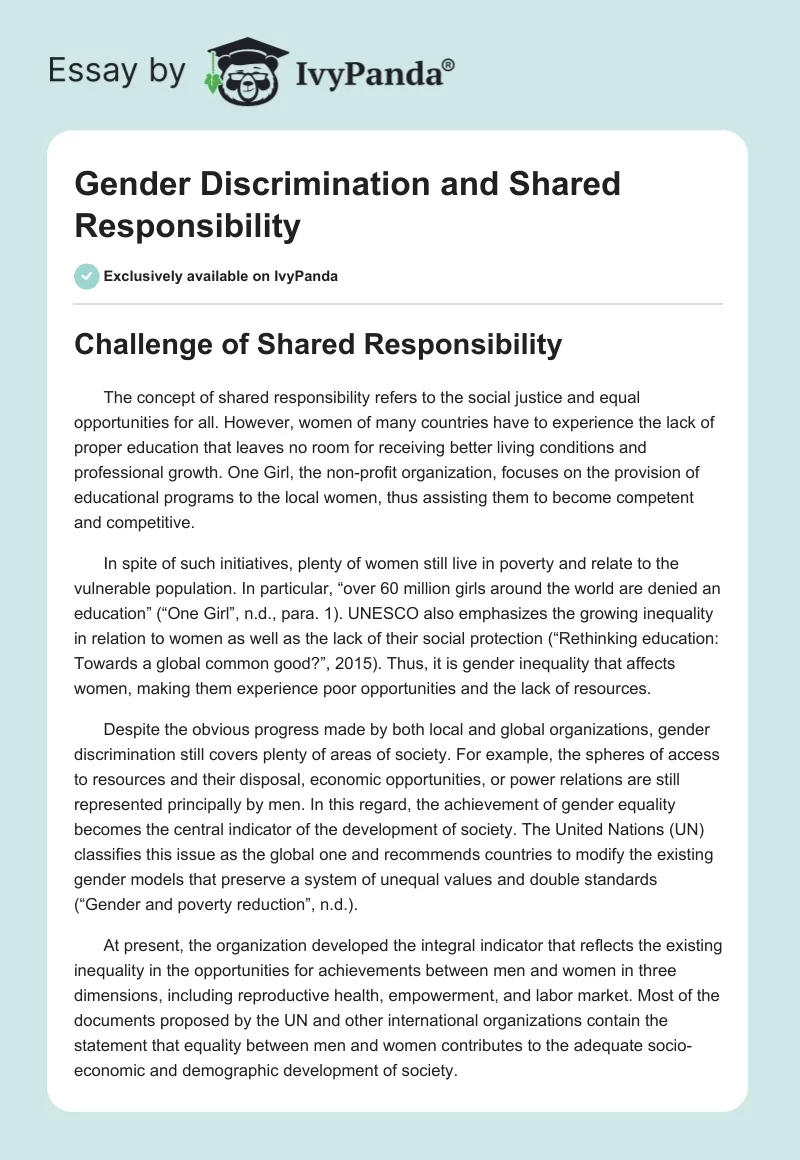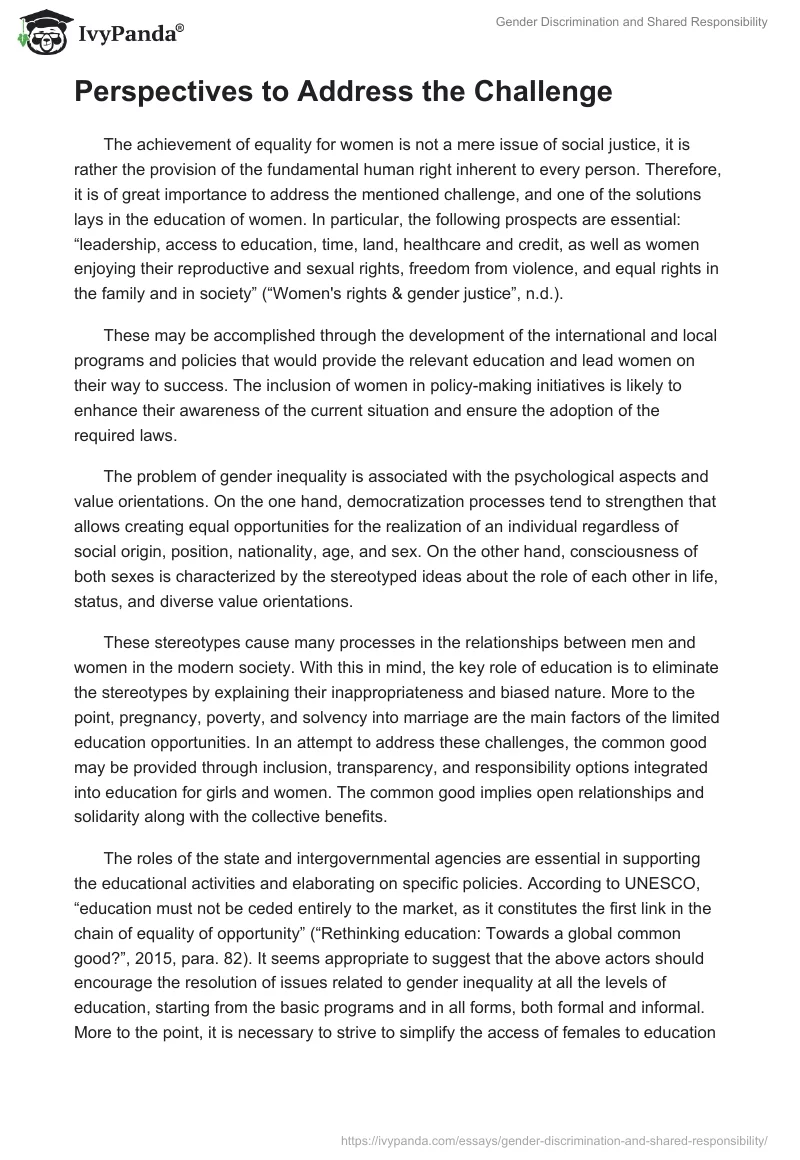Challenge of Shared Responsibility
The concept of shared responsibility refers to the social justice and equal opportunities for all. However, women of many countries have to experience the lack of proper education that leaves no room for receiving better living conditions and professional growth. One Girl, the non-profit organization, focuses on the provision of educational programs to the local women, thus assisting them to become competent and competitive.
In spite of such initiatives, plenty of women still live in poverty and relate to the vulnerable population. In particular, “over 60 million girls around the world are denied an education” (“One Girl”, n.d., para. 1). UNESCO also emphasizes the growing inequality in relation to women as well as the lack of their social protection (“Rethinking education: Towards a global common good?”, 2015). Thus, it is gender inequality that affects women, making them experience poor opportunities and the lack of resources.
Despite the obvious progress made by both local and global organizations, gender discrimination still covers plenty of areas of society. For example, the spheres of access to resources and their disposal, economic opportunities, or power relations are still represented principally by men. In this regard, the achievement of gender equality becomes the central indicator of the development of society. The United Nations (UN) classifies this issue as the global one and recommends countries to modify the existing gender models that preserve a system of unequal values and double standards (“Gender and poverty reduction”, n.d.).
At present, the organization developed the integral indicator that reflects the existing inequality in the opportunities for achievements between men and women in three dimensions, including reproductive health, empowerment, and labor market. Most of the documents proposed by the UN and other international organizations contain the statement that equality between men and women contributes to the adequate socio-economic and demographic development of society.
Perspectives to Address the Challenge
The achievement of equality for women is not a mere issue of social justice, it is rather the provision of the fundamental human right inherent to every person. Therefore, it is of great importance to address the mentioned challenge, and one of the solutions lays in the education of women. In particular, the following prospects are essential: “leadership, access to education, time, land, healthcare and credit, as well as women enjoying their reproductive and sexual rights, freedom from violence, and equal rights in the family and in society” (“Women’s rights & gender justice”, n.d.).
These may be accomplished through the development of the international and local programs and policies that would provide the relevant education and lead women on their way to success. The inclusion of women in policy-making initiatives is likely to enhance their awareness of the current situation and ensure the adoption of the required laws.
The problem of gender inequality is associated with the psychological aspects and value orientations. On the one hand, democratization processes tend to strengthen that allows creating equal opportunities for the realization of an individual regardless of social origin, position, nationality, age, and sex. On the other hand, consciousness of both sexes is characterized by the stereotyped ideas about the role of each other in life, status, and diverse value orientations.
These stereotypes cause many processes in the relationships between men and women in the modern society. With this in mind, the key role of education is to eliminate the stereotypes by explaining their inappropriateness and biased nature. More to the point, pregnancy, poverty, and solvency into marriage are the main factors of the limited education opportunities. In an attempt to address these challenges, the common good may be provided through inclusion, transparency, and responsibility options integrated into education for girls and women. The common good implies open relationships and solidarity along with the collective benefits.
The roles of the state and intergovernmental agencies are essential in supporting the educational activities and elaborating on specific policies. According to UNESCO, “education must not be ceded entirely to the market, as it constitutes the first link in the chain of equality of opportunity” (“Rethinking education: Towards a global common good?”, 2015, para. 82). It seems appropriate to suggest that the above actors should encourage the resolution of issues related to gender inequality at all the levels of education, starting from the basic programs and in all forms, both formal and informal. More to the point, it is necessary to strive to simplify the access of females to education either in the formal or informal way, utilizing innovative approaches such as information and communication technologies (ICT) (van der Meulen Rodgers & Zammit, 2009).
The latter is especially important in terms of the rapid development of the Internet and digital technologies. One more option is to promote the development of gender-sensitive educational programs and discrimination-free materials. Ultimately, it is also significant to assist countries and organizations in the struggle against gender-based violence in educational institutions, thus attracting more female students to receive education.
Considering this global issue on the local scale, it is also possible to contribute to its elimination through integrating specific activities into the classroom environment. For example, a teacher may initiate discussions regarding gender stereotypes, involving both males and females and empowering them to reveal their views and perceptions on this theme (“Promoting gender equity in the classroom”, n.d.).
The mentioned assumption is likely to facilitate the open dialogue and provide a valuable platform for the interaction. For example, students may tell their own stories or note the ones observed in news, movies, or other sources. At this point, a teacher should focus on the equal rights of men and women, making sure that every student understands bias of the stereotypes along with the need to eradicate them.
The attention to the classroom setting details also matters. For example, a teacher should avoid generalizations and limitations related to gender, such as “girls tend to… or boys are more… “ (“Promoting gender equity in the classroom”, n.d.). The use of the neutral language would prevent the focus on gender differences and improve the perception of girls. In particular, a teacher should be strict solely with boys or gentle only with girls as these leads directly to the stereotypes.
Also, the examples from real life or fictional ones may be used as the so-called “teaching moments” that represent the essence of the problem and let students consider it from their point of view. These examples may be discussed twice to check whether the teaching activities make any effect or not. For example, it is evident that some students are likely to resist gender equality initiatives based on their established perception, family attitude, or some other factors. Therefore, it is of great importance to remind the discussed stories and check the potential progress.
It should also be noted that the role of a teacher implies engagement of girls in the activities that, according to stereotypes, are considered to be male. This concerns, for instance, dancing or sports – the spheres that are primarily presented by boys. However, it is obvious that girls may also dance and play football, thus proving that they are full-fledged members of society. The promotion of interaction between students of different gender, be it sports or communication, encourages them to apply teamwork for collaboration. Such an approach would make males and females closer to each other in terms of understanding, respect, and acceptance.
References
Gender and poverty reduction. (n.d.). Web.
One Girl. (n.d.). Web.
Promoting gender equity in the classroom. (n.d.). Web.
Rethinking education: Towards a global common good? (2015). Web.
van der Meulen Rodgers, Y., & Zammit, A. (Eds.) (2009). Social justice and gender equality: Rethinking development strategies and macroeconomic policies. New York, NY: Routledge.
Women’s rights & gender justice. (n.d.). Web.


